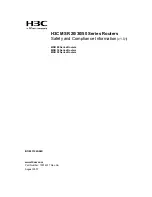Reviews:
No comments
Related manuals for NAS-7410

610
Brand: IBM Pages: 40

i Series
Brand: IBM Pages: 908

SR8800 IM-FW-II
Brand: H3C Pages: 107

MSR 50 Series
Brand: 3Com Pages: 12

S9500 Series
Brand: H3C Pages: 16

H3C S3600 Series
Brand: H3C Pages: 10

MSR 930
Brand: H3C Pages: 42

MSR 800
Brand: H3C Pages: 2

MSR Series
Brand: H3C Pages: 33

CR16000-F
Brand: H3C Pages: 14

MSR 3600
Brand: H3C Pages: 56

H3C S7500E Series
Brand: H3C Pages: 112

S3100-52P
Brand: H3C Pages: 15

MSR810
Brand: H3C Pages: 37

CR16000-F
Brand: H3C Pages: 4

MSR 20-1X
Brand: H3C Pages: 5

RA10
Brand: H3C Pages: 4

MSR Series
Brand: H3C Pages: 166

















